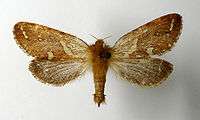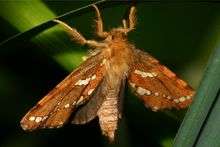Gold swift
The gold swift (Phymatopus hecta) is a moth belonging to the family Hepialidae. Until recently it was placed in the genus Hepialus. The species was first described by Carl Linnaeus in his 1758 10th edition of Systema Naturae. It is a widespread species of Europe, its distribution following that of its food plant, bracken.

| Gold swift | |
|---|---|
 | |
| Scientific classification | |
| Kingdom: | |
| Phylum: | |
| Class: | |
| Order: | |
| Family: | |
| Genus: | |
| Species: | P. hecta |
| Binomial name | |
| Phymatopus hecta | |
| Synonyms | |
| |
Life history
This is a rather small moth for the family, with a wingspan of 26–32 mm. The male is distinctive, the brown forewings marked with two parallel bands of white markings. The larger female is less striking with muted grey-and-brown markings. The adult is on the wing in June and July (this refers to the British Isles; other parts of the range may differ) and both sexes are moderately attracted to light. To attract females, the male emits a scent rather similar to pineapple.
The larva feeds internally on the stems and roots of bracken, taking two years to reach full size, when it emerges to pupate in the ground.
The adult moths spend most of the 24 hours resting, in a wide variety of places from the tree canopy to the base of the ground vegetation. They are active only for two brief periods: for an hour or two around sunset, when they mate and previously mated females lay eggs; and then very briefly for about 15 minutes at sunrise, when mating pairs separate, and males that have remained overnight in exposed positions move to less visible places.[1] Very occasionally, and usually in mountainous areas, there is a period of activity in the mid-afternoon.[2]
Courtship and mating
The mating system is spectacular,[3] but rarely observed because it takes place in the late evening, on either side of sunset. A number of males gather in one limited space and start to display, alternating between perching on the vegetation with their wings spread out, or flying rapidly in a figure of 8 pattern which is so quick that the human eye interprets it as a “pendulum” motion. The males prominently dangle their modified hindlegs, which end in yellow brushes that disperse an attractive scent, or pheromone. Males also fight: either swinging into each other, or rising in the air in a vibrating dance, in which they try to exhaust each other. The loser usually flies right away, off site.
Females fly onto the site, and courtships take place in a bewildering variety. The female may fly to one of the perched males, or to a perch of her own choosing; she may be pursued on the way by one or more males, or males may fly to her after she perches. Or she may perform a mutual courtship dance with a flying male. Or a male and female, both perched, may approach each other by progressive changes of perch. Coupling is acrobatic and “front to back”: the pair hang with the male in front and the female behind, facing the same way, and by a corkscrew action of the abdomens finish with the female hanging vertically by her front feet, and the male dangling upside down and held to her only by the grip of the genitalia. They remain in this posture until the following dawn.
Some authorities believe that this mating system constitutes a lek (or lek mating), analogous to the mating of black grouse,[4] in which females prefer to mate with a single dominant male whose display behaviour has demonstrated his superiority to all the other males.[5] Others believe that the swift moths are radically different from the grouse, and constitute a functional mate acquisition system, or male mating swarm.[6][7]
References
- J.R.G. Turner. 2013. The dawn flight of the gold swift Hepialus hecta: predator avoidance and the integration of complex lek behaviour (Lepidoptera, Hepialidae). Biological Journal of the Linnean Society 110: pp. 305–319.
- J.R.G. Turner. 2014. Anomalous daylight flight in Phymatopus hecta (Linnaeus, 1758) and other crepuscular and nocturnal moths (Lepidoptera: Hepialidae, Geometridae). Entomologist’s Gazette 65: pp. 97–104.
- J.R.G. Turner 2015 The flexible lek: Phymatopus hecta the gold swift demonstrates the evolution of leking and male swarming via a hotspot (Lepidoptera: Hepialidae). Biological Journal of the Linnean Society, 114, pp. 184–201.
- J. Höglund and R.V. Alatalo. 1995. Leks. Princeton, NJ: Princeton University Press
- J. Mallet. 1984. Sex roles in the ghost moth Hepialus humuli (L.) and a review of mating in the Hepialidae (Lepidoptera). Zoological Journal of the Linnean Society 79: pages 67–82.
- P.L. Phelan. 1997. Evolution of mate-signalling in moths: phylogenetic considerations and predictions from the asymmetric tracking hypothesis. In: Choe J.C. Choe and B.J. Crespi, eds. The evolution of mating systems in insects and arachnids. Cambridge: Cambridge University Press, pages 273–293.
- T.E. Shelly and T.S. Whittier.1997. Lek behaviour of insects. In: J.C. Choe and B.J. Crespi, eds. The evolution of mating systems in insects and arachnids. Cambridge: Cambridge University Press, pages 294–309.
- Skinner, Bernard (1984). The Colour Identification Guide to Moths of the British Isles.
- Waring, Paul & Townsend, Martin (2003). Field Guide to the Moths of Great Britain and Ireland.
External links
| Wikimedia Commons has media related to Phymatopus hecta. |
| Wikispecies has information related to Phymatopus |
- Kimber, Ian. "3.004 BF16 Gold Swift Phymatopus hecta (Linnaeus, 1758)". UKMoths. Retrieved 30 June 2019.
- Fauna Europaea
- Lepiforum e.V.
- De Vlinderstichting (in Dutch)